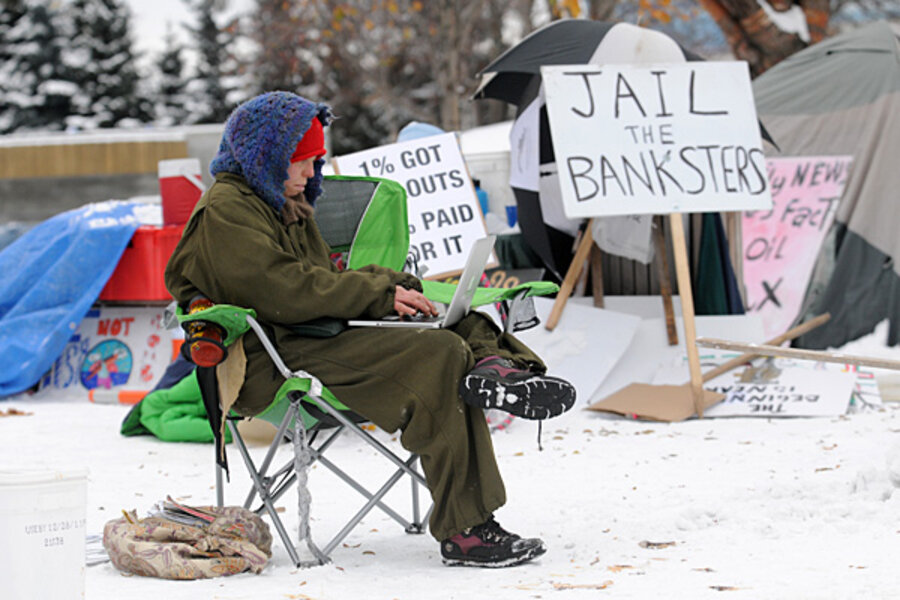Occupy Wall Street: Can filmmaking website unify the movement?
Loading...
| Los Angeles
Amid the rumbling backdrop of incessant drumming in the 450-tent strong encampment here, Lisa Clapier is demonstrating the newest, high-tech tool that some in the Occupy Wall Street movement say may finally help them unify their message worldwide.
On her humming laptop in the media tent, Ms. Clapier navigates to StudioOccupy.org where activists have placed 17 pages (so far) of stamp-sized, clickable links, each taking the user to videos, images, or audio uploaded by participants. Some are of live demonstrations in New York or Los Angeles, others are personalized messages of solidarity by random supporters (or celebrities such as Deepak Chopra), others are merely photographs of protesters having fun.
Think YouTube, but better, say its fans.
“This is amazing,” says Clapier, spokeswoman for the Los Angeles Occupiers. “Now every single person can become their own storyteller with their own cell phone or webcam. They can upload and edit their own content and have it be shared with all the other occupiers around the planet.”
By placing all their own content on a “cloud” server – with unlimited storage space that all can access – various encampments can create a universal video, image, and audio database that all can use to create individual messages, using other’s footage as well as their own. Users can create “call outs” – wish lists of footage needed with specific content and specific dates – and will eventually be able to find the return submissions by typing in key words such as “pepper spray,” “chanting,” or “police on horseback.”
After three months of beta-testing, the new platform was unveiled Tuesday. Soon to come are complete editing banks and tutorials that teach users how to edit, splice, and mix images and sound.
“This is such an advance over the old way, it’s hard to explain,” says Lee Jon Taylor, considered one of Occupy L.A.’s best editors. “I used to have to call people and ask if they had any footage of this and that, and then get permission from them to access their hard drives. Some of them didn’t want to do that, and the process was so cumbersome.”
Mr. Taylor and Clapier say the advantages are a quantum leap over such current sites such as YouTube, because the clips can be longer, can be labeled and cross referenced more easily, and the individual shooter retains copyrights.
“This is the first, truly free media,” says Taylor.
The new platform has been donated by Citizen Global, a Venice, Calif.-based firm that creates ways for businesses to communicate with their customers.
“[Citizen Global CEO] Steven Starr is betting his reputation on this as a true gift because he supports the movement politically, ideologically, and spiritually, “ says Occupy L.A. project coordinator, Jeff Vander Clute.
One of Citizen Global's existing applications has long been used by Hollywood film studios to put out pleas for various kinds of content footage, such as home movies and old photographs for use in major motion pictures.
“We are looking to be of service and for the demonstration of co-creativity,” says Mr. Starr, who has worked with musician activists such as Bob Marley and produced the film “Flow” about water rights.
Some sociologists and media analysts say the idea may have as much promise as the Occupy leadership hope.
“StudioOccupy has the potential of being a ‘game changer’ for the Occupy movement as a whole, by going beyond the neatly circumscribed political and media-driven categories prevalent in civic life," says Professor Catherine Wilson, who studies social movements at Villanova University. "This platform allows Occupy to engage American political culture on their own terms and in their own way. Occupy has prided itself on being an alternative movement – now they have an alternative media platform – that allows the movement to bypass a variety of intermediaries and take their message directly to the American people.”
Fordham University communications professor, Paul Levinson, author of “New New Media,” says the new platform gives the Occupy movement a boost at a key moment in its development that could be crucial to its future.
“The difference between today and protests of the past is that just about everyone with a cell phone can take a video, so little can be kept secret about demonstrations and the response of authorities. But what is still needed is a central place, where all of the videos and manifestos can be easily accessed. OccupyStudio looks an important development in this direction.”
Other academics worry that the new idea could diffuse some of the live energy of the groups, generated by on-the-street protests, encampments, and marches by diverting attention to essentially passive, online viewing.
"StudioOccupy is proof positive that the Occupy Wall Street movement is on the verge of becoming a harmless pastime, as people post their 'narratives' on a web site that supposedly reflects and initiates social change,” says Dr. Ben Agger, director of the Center for Theory at the University of Texas, Arlington's Sociology department, in an email . “This Facebook-ification of OWS will be easily absorbed, no longer possessing a transgressive and progressive potential. Instead, social change will become merely self-expression. The revolution cannot be blogged."
But his comment doesn’t fly with many here at the Los Angeles encampment at City Hall.
“That doesn’t sound like a very informed statement,” says Alissa Kokkins, a screenwriter who has been with Occupy L.A. since it began here October 1. “Facebook is one of the keys to putting together activism, sharing information, and problem solving. Just the fact that we all come together online in addition to being out in the communities, doesn’t halt or slow the revolution.”





